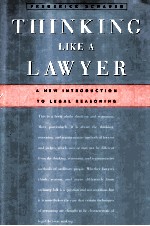

THINKING LIKE A LAWYER A NEW INTRODUCTION TO LEGAL REASONINGPDF电子书下载
- 电子书积分:10 积分如何计算积分?
- 作 者:FREDERICK SCHAUER
- 出 版 社:HARVARD UNIVERSITY PRESS
- 出版年份:2009
- ISBN:0674032705
- 页数:239 页
1 Introduction: Is There Legal Reasoning? 1
2 Rules—in Law and Elsewhere 13
2.1 Of Rules in General 13
2.2 The Core and the Fringe 18
2.3 The Generality of Rules 24
2.4 The Formality of Law 29
3 The Practice and Problems of Precedent 36
3.1 Precedent in Two Directions 36
3.2 Precedent—The Basic Concept 37
3.3 A Strange Idea 41
3.4 On Identifying a Precedent 44
3.5 Of Holdings and Dicta 54
3.6 On the Force of Precedent—Overruling, Distinguishing,and Other Types of Avoidance 57
4 Authority and Authorities 61
4.1 The Idea of Authority 61
4.2 On Binding and So-Called Persuasive Authority 67
4.3 Why Real Authority Need Not Be “Binding” 75
4.4 Can There Be Prohibited Authorities? 77
4.5 How Do Authorities Become Authoritative? 80
5 The Use and Abuse of Analogies 85
5.1 On Distinguishing Precedent from Analogy 85
5.2 On the Determination of Similarity 92
5.3 The Skeptical Challenge 96
5.4 Analogy and the Speed of Legal Change 100
6 The Idea of the Common Law 103
6.1 Some History and a Comparison 103
6.2 On the Nature of the Common Law 108
6.3 How Does the Common Law Change? 112
6.4 Is the Common Law Law? 117
6.5 A Short Tour of the Realm of Equity 119
7 The Challenge of Legal Realism 124
7.1 Do Rules and Precedents Decide Cases? 124
7.2 Does Doctrine Constrain Even If It Does Not Direct? 134
7.3 An Empirical Claim 138
7.4 Realism and the Role of the Lawyer 142
7.5 Critical Legal Studies and Realism in Modern Dress 144
8 The Interpretation of Statutes 148
8.1 Statutory Interpretation in the Regulatory State 148
8.2 The Role of the Text 151
8.3 When the Text Provides No Answer 158
8.4 When the Text Provides a Bad Answer 163
8.5 The Canons of Statutory Construction 167
9 The Judicial Opinion 171
9.1 The Causes and Consequences of Judicial Opinions 171
9.2 Giving Reasons 175
9.3 Holding and Dicta Revisited 180
9.4 The Declining Frequency of Opinions 184
10 Making Law with Rules and Standards 188
10.1 The Basic Distinction 188
10.2 Rules, Standards, and the Question of Discretion 190
10.3 Stability and Flexibility 194
10.4 Rules and Standards in Judicial Opinions 196
10.5 On the Relation between Breadth and Vagueness 200
11 Law and Fact 203
11.1 On the Idea of a Fact 203
11.2 Determining Facts at Trial—The Law of Evidence and Its Critics 206
11.3 Facts and the Appellate Process 212
12 The Burden of Proof and Its Cousins 219
12.1 The Burden of Proof 219
12.2 Presumptions 224
12.3 Deference and the Allocation of Decision-Making Responsibility 229
Index 235
- 《古典吉他精选曲集 浪漫主义时期》弗雷德里克·诺德(Frederick Noad)编著;好好艺术工作室编译 2013
- 《运筹学 作业研究 导论 第4版》(美)F.S.希勒(Frederick S.Hiller),(美)G.J.利伯曼(Gerald J.Lieberman)著;方世荣译 1995
- 《当代聚合物化学 原著第3版》(美)H. R·阿尔库克(Harry R. Allcock),(美)F. W·兰普(Frederick W. Lampe),(美)J. E·马克(James E. Mark)著;张其锦,董炎明,宗惠娟等译 2006
- 《缺角的孩子》瑞克·白伦斯坦(Frederick H·Berenstein)著;史锡蓉译 2001
- 《浪尖上的宝洁 lessons from 165 years of brand building at procter & gamble》(美)戴维斯·戴尔(Davis Dyer),(美)弗雷德里克·达尔泽尔(Frederick Dalzell),(美)罗伊纳·奥利加里欧(Rowena Olegario)著;兰燕卓译 2006
- 《从爱迪生到ipod》Frederick Mostert著 2009
- 《设计组织小学课程论》Frederick Gordon Bonser著;郑宗海,沈子善译 1931
- 《设计组织小学课程论》Frederick Gordon Bonser著;郑宗海,沈子善译 1933
- 《碳酸盐岩层序地层学 近期进展及应用》(美)Robert G. Loucks,(美)J. Frederick Sarg著;马永生等译 2003
- 《疾病改变历史》(英)弗雷德里克·F.卡特赖特(Frederick Cartwright),(英)迈克尔·比迪斯(Michael Biddiss)著;陈仲丹,周晓政译 2004
- 《中国“80后”大学教师胜任力评价研究=RESEARCH ON THE EVALUATION OF CHINA'S POST 80s GENERATION UNIVERSITY TEACHERS' CO》黄艳著 2013
- 《解读好莱坞:电影的空间与意义》Deborah Thomas著;李达义,曹玉玲译 2004
- 《会说话的星图 星座篇》徐历涛著 2014
- 《可靠性工程与风险管理 第3辑 英文版》赵衍刚编 2012
- 《竞争战略 全译珍藏版》(美)迈克尔·波特(Michael E. Porter)著 2012
- 《中国材料名师讲坛 第1辑》谢建新主编 2012
- 《翻译能力的培养》舍夫娜,阿达巴编 2012
- 《大学生外语口语焦虑 自我图式的视角 for university students: in the view of self-schema》巫文胜著 2014
- 《都柏林大学的教育内涵与实践 探索世界高水平大学发展之路 explore the development of the world high-level university》李全宏编著 2013
- 《物理学 卷1 力学和热学 医学、生物等专业适用 英文改编版原书第4版》AlanGiambattista,BettyMcCarthyRichardson著 2013
